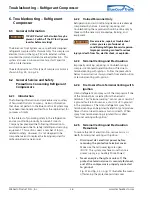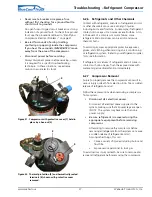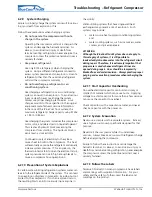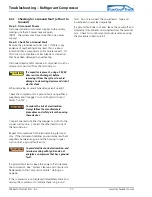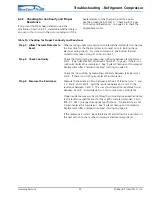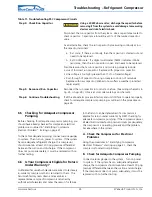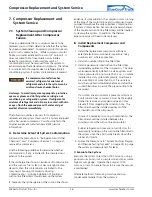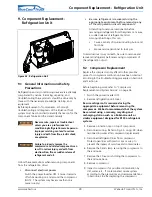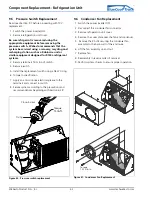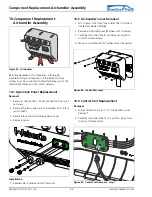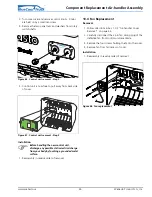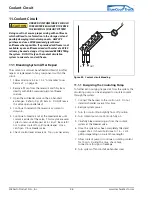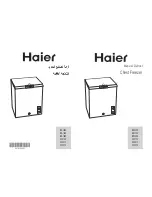
Troubleshooting – Refrigerant Compressor
www.webasto.us
31
Webasto Product N.A., Inc.
™
6.4
Identifying Compressor Electrical
Problems
This section describes procedures for checking the
compressor’s electrical circuits and components. Before
doing so, follow the BlueCool Truck System service
information under “Troubleshooting – BlueCool Truck
Electrical System” starting on page 14 to make sure the
system is getting proper voltage and that the digital
temperature sensor, control module, and relays are
working properly.
Whenever you suspect that there is an electrical problem
with the compressor (for example, there has been a
tripped circuit breaker):
•
FIRST, check for a ground fault (also known as a
short circuit to ground) in the motor using a
megohmmeter (“megger”) or a Hi-Potential
Ground Tester (“Hi-Pot”) (Section 6.4.1).
•
SECOND, check the motor windings for proper
continuity and resistance (Section 6.4.2).
•
THIRD, check the compressor’s electrical
components (Section 6.4.3).
When checking for electrical problems, it is important to
follow all safety precautions (see warning below) and use
the proper equipment and procedures.
Oil and refrigerant can spray out of the
compressor if one of the terminal pins is
ejected from the hermetic terminal.
This can occur as a result of a ground fault in the
compressor. The oil and refrigerant spray can be ignited
by electricity and produce flames that can lead to serious
burns or death. If this spray is ignited it is called
“terminal venting with ignition”.
To reduce the risk of electrocution, serious burns or death
from terminal venting with ignition:
•
Disconnect ALL electrical power before removing
the protective terminal cover.
•
Never energize the system unless:
•
the protective terminal cover is securely
fastened, and
•
the compressor is properly connected to
ground.
•
Never reset a breaker or replace a fuse without first
checking for a ground fault. An open fuse or
tripped circuit breaker is a strong indication of a
ground fault.
•
Be alert for sounds of arcing (sputtering or
popping) inside the compressor. If you hear these
sounds, IMMEDIATELY move away from the area
of the compressor.
Unit runs OK, but run cycle
is shorter than normal (due
to component (s) other
than thermal protector)
System components, such as digital temperature sensor,
control module, relays, not functioning properly.
Refer to the BCT “Troubleshooting - BlueCool Truck
Electrical System” starting on page 14.
High pressure cut-out due to:
a. Insufficient air or coolant supply.
b. Overcharge or refrigerant.
c. Air in system.
Refer to the BCT service information.
Same as “a”.
Same as “a”.
Low pressure cut-out due to:
a. Refrigerant leaking.
b. Undercharge of refrigerant.
c. Restriction in Thermal Expansion Valve.
Refer to the BCT service information.
Same as “a”.
Same as “a”.
Unit operates long or
continuously
Undercharge of refrigerant.
Refer to the BCT service information.
System components, such as digital temperature sensor,
control module, relays, not functioning properly.
Refer to the BCT service information.
Restriction in refrigeration circuit.
Refer to the BCT service information.
Dirty condenser.
Refer to the BCT service information.
System rattles or vibrates
during operation.
Loose parts or mountings, tubing rattle, bent fan blade
causing vibration, fan motor bearings worn, etc.
Refer to the BCT service information.
Table 9. Troubleshooting Table – Refrigerant Compressor and Related Components
Symptom
Possible Causes
Remedy
WARNING










